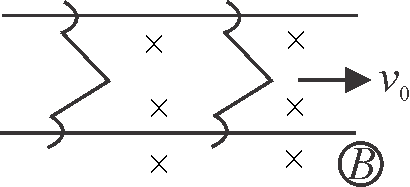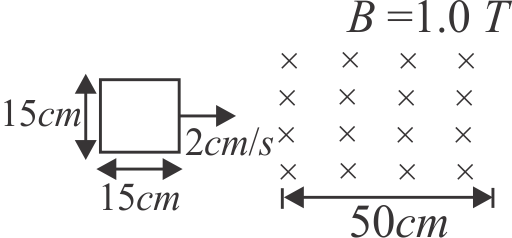358493
In figure, there are two sliders and they can slide on two frictionless parallel wires in uniform magnetic field \({B}\), which is present everywhere. The mass of each slider is \({m}\), resistance \({R}\) and initially these are at rest. Now, if one slider is given a velocity \({v_{0}=16 {~m} {~s}^{-1}}\), what will be the velocity of other slider after long time? (neglect the self-induction)
358493
In figure, there are two sliders and they can slide on two frictionless parallel wires in uniform magnetic field \({B}\), which is present everywhere. The mass of each slider is \({m}\), resistance \({R}\) and initially these are at rest. Now, if one slider is given a velocity \({v_{0}=16 {~m} {~s}^{-1}}\), what will be the velocity of other slider after long time? (neglect the self-induction)
358493
In figure, there are two sliders and they can slide on two frictionless parallel wires in uniform magnetic field \({B}\), which is present everywhere. The mass of each slider is \({m}\), resistance \({R}\) and initially these are at rest. Now, if one slider is given a velocity \({v_{0}=16 {~m} {~s}^{-1}}\), what will be the velocity of other slider after long time? (neglect the self-induction)
358493
In figure, there are two sliders and they can slide on two frictionless parallel wires in uniform magnetic field \({B}\), which is present everywhere. The mass of each slider is \({m}\), resistance \({R}\) and initially these are at rest. Now, if one slider is given a velocity \({v_{0}=16 {~m} {~s}^{-1}}\), what will be the velocity of other slider after long time? (neglect the self-induction)
358493
In figure, there are two sliders and they can slide on two frictionless parallel wires in uniform magnetic field \({B}\), which is present everywhere. The mass of each slider is \({m}\), resistance \({R}\) and initially these are at rest. Now, if one slider is given a velocity \({v_{0}=16 {~m} {~s}^{-1}}\), what will be the velocity of other slider after long time? (neglect the self-induction)


